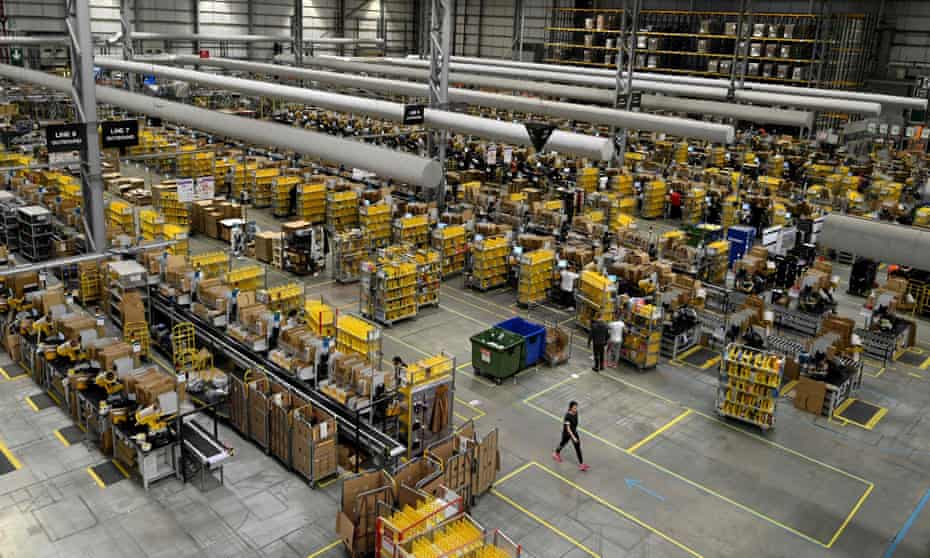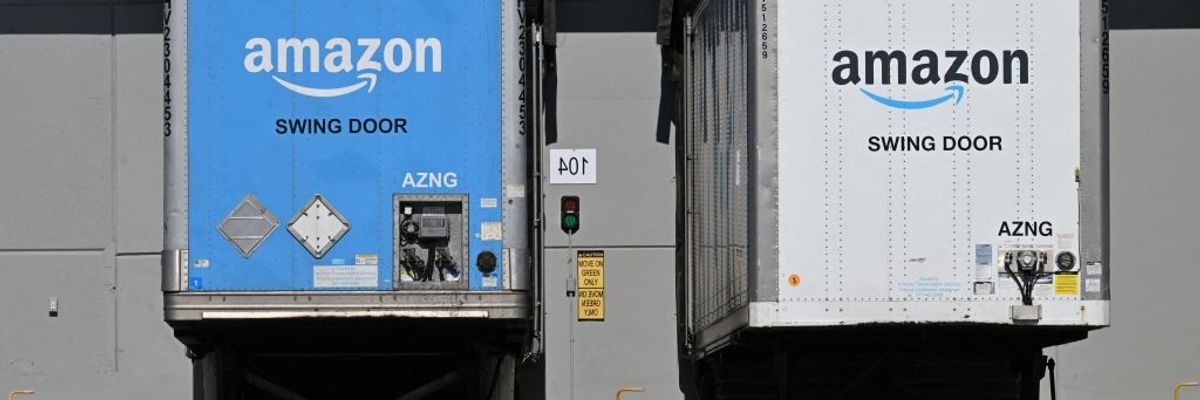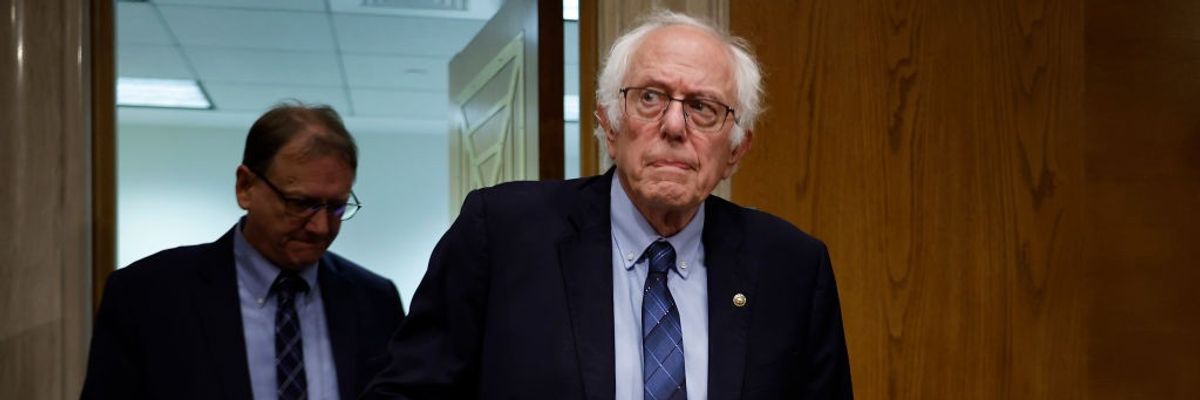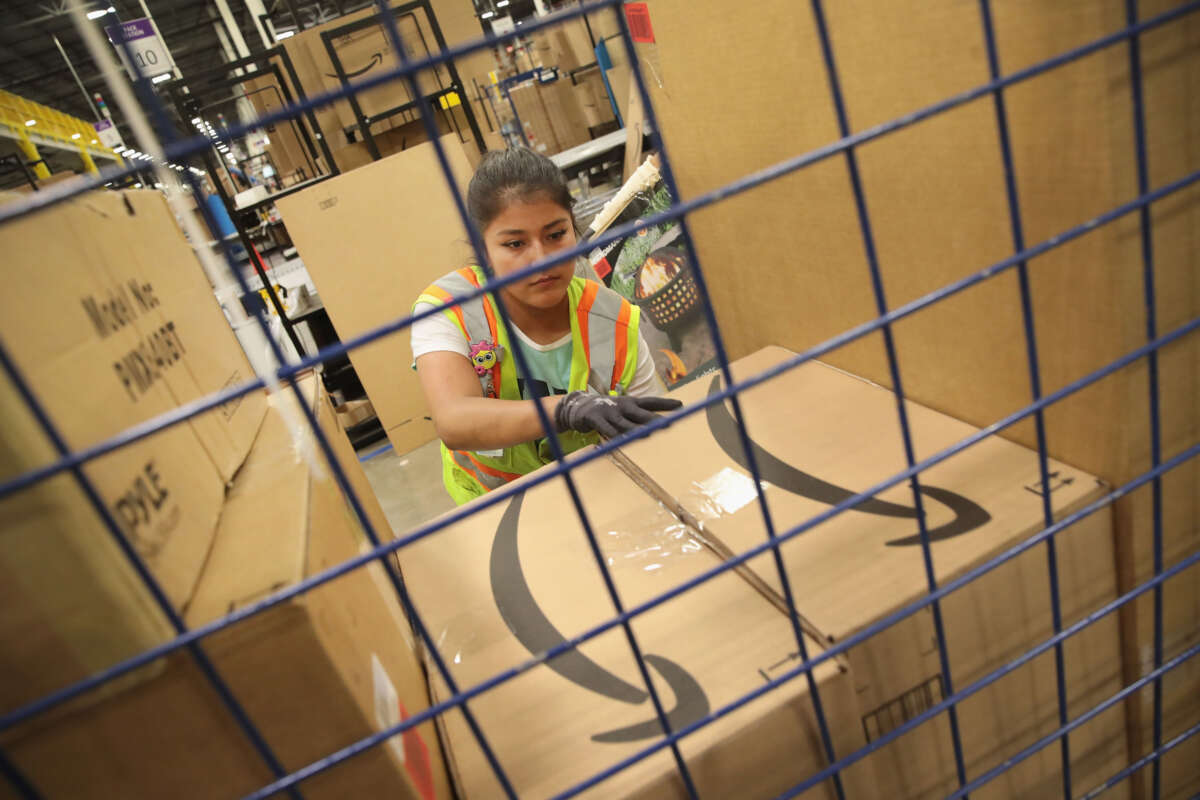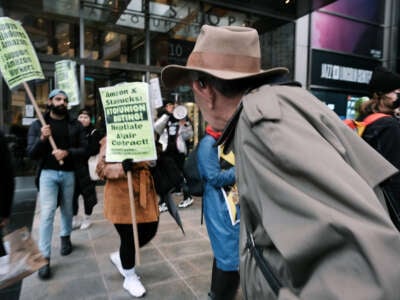CRIMINAL CAPITALI$M
Amazon punished its own sellers to limit Walmart's reach, FTC saysThu, November 2, 2023


By Siddharth Cavale and Arriana McLymore
NEW YORK (Reuters) - Amazon.com Inc punished its own sellers to limit Walmart's reach as Walmart got into e-commerce, according to the Federal Trade Commission (FTC).
In addition to making $1 billion by using a secret algorithm called "Project Nessie" to push up the prices that U.S. households pay, Amazon may have also succeeded in curbing Walmart's ambitions.
In 2014, the arrival of Jet.com triggered fear at Amazon that Jet.com would be able to offer shoppers lower prices online, the FTC said on Thursday, kick-starting Amazon's strategy of removing sellers’ offers from the Buy Box if shoppers could find the same products at lower prices on Jet.com. The Buy Box is the button that allows shoppers to make a purchase directly from a seller.
Walmart acquired Jet.com in 2016.
"Given Amazon's size and a scale, their quantitative analytical might, and particularly, against the background that they had not made a profit on (Amazon.com) for the first 20 years, it's not surprising that they would resort to such tactics against competitors," retail consultant Burt Flickinger said.
Like Amazon, Walmart operates a third-party online marketplace, with merchandise from thousands of independent sellers. On Amazon, millions of independent merchants currently sell goods its marketplace. Both Walmart and Amazon collect fees and commissions from the merchants on their platforms.
By not collecting seller commissions, Jet.com could offer prices that were 10% to 15% lower than what Amazon advertised, the FTC said in a less-redacted version of a previous complaint against Amazon. This, Amazon realized, could result in sellers passing on those savings to customers, the FTC said.
To hamstring Jet.com, Amazon removed some third-party sellers' offers from its Buy Box. The complaint cites one Amazon seller who adopted a policy of making "absolutely sure that our products are not priced lower on Walmart than they are on Amazon" because of pressure from Amazon.
Amazon also deployed what the FTC described as anti-competitive algorithms against Jet.com's most popular products leading to Jet revising its strategy to match the lowest prices elsewhere, the FTC said.
Amazon spokesperson Tim Doyle said the FTC "grossly mischaracterizes" the pricing tool and the company stopped using it several years ago.
Walmart shut down Jet in 2020 and incorporated it into its wider e-commerce business.
Walmart declined to comment as it was not part of the FTC litigation, a spokesperson said.
(Reporting by Siddharth Cavale and Arriana McLymore in New York; Editing by Vanessa O'Connell and Lisa Shumaker)
Amazon Boosted Junk Ads, Deleted Messages to Thwart Antitrust Probe, FTC Says
Leah Nylen and Matt Day
Thu, November 2, 2023

(Bloomberg) -- Amazon.com Inc. doubled the number of junk ads to boost profits and deleted internal communications to thwart a federal antitrust probe, according to fresh details released by the US Federal Trade Commission in a less redacted complaint against the online retail giant Thursday.
Amazon’s founder and former Chief Executive Officer Jeff Bezos personally ordered executives to accept more ads, even ones the company had internally labeled as “defects,” indicating they weren’t relevant to user searches, according to the new version of the complaint.
The FTC alleges that Amazon’s increased use of ads boosts profits while it harms sellers and consumers, making it harder for shoppers to find products they are searching for. “We’d be crazy not to” increase the number of advertisements shown to shoppers,” the FTC quoted Amazon executives as saying.
One executive compiled a number of the defective ads showing “buck urine” showing up in response to searches for “water bottles” or T-shirts for the Los Angeles Lakers basketball team in response to queries for the Seattle Seahawks football team merchandise.
In third quarter 2023 earnings announced last week, Amazon reported advertising revenue of $12.1 billion, making the company’s ad unit its fastest-growing business.
Amazon said its search results consider a number of factors and users can easily refine their results.
“Amazon works hard to make it fast and easy for customers to find the items they want and discover similar options by providing a mix of organic and sponsored search results,” Amazon spokesperson Tim Doyle said. He also cited a study by a London marketing firm that found consumers find Amazon ads relevant and useful.
In an email later Thursday, he added: “The claim that Amazon leadership directed employees to accept more advertising defects that would degrade the customer experience is grossly misleading and taken out of context, and does not reflect Amazon’s longstanding dedication to continually improving the customer experience.”
‘Disappearing Message’
The FTC also alleged that the company deleted internal communications using the “disappearing message” feature of Signal and destroyed more than two years’ worth of such communications, from June 2019 to at least early 2022.
Amazon denied that its employees deleted messages, saying the company informed the FTC about the Signal usage, “painstakingly collected Signal conversations from its employees’ phones, and allowed agency staff to inspect those conversations.” Some executives began to use the encrypted communications app after Bezos disclosed in 2019 that his phone had been hacked and alleged the National Enquirer tabloid sought to publish his intimate photos and texts.
The agency sued Amazon in September, accusing the e-commerce giant of monopolizing online marketplace services and stifling competition. The complaint alleges the company illegally forces sellers on its platform to use its logistics and delivery services in exchange for prominent placement and punishes merchants who offer lower prices on competing sites.
Amazon has said it will challenge the lawsuit in court, adding that it “radically” departs from the agency’s mission of protecting consumers and is “wrong on the facts and the law.”
The original complaint was heavily redacted, blacking out information about Amazon’s operations, including details about the company’s scale, its Prime subscriber base and a pricing algorithm called “Project Nessie” that the agency said foisted higher costs on shoppers, belying the company’s claim to prioritize the welfare of its customers.
Over the ensuing weeks, the FTC and Amazon wrangled over what details could be publicly shared, with the company determined to protect information that could provide competitors insights into its e-commerce strategy and business metrics.
Seller Fulfilled Prime
According to the FTC’s new complaint, 98% of Amazon sales occur directly from the so-called “Buy Box” where the company selects one featured offer from among the sellers hawking a specific product.
The FTC alleges that Amazon has illegally tied use of its marketplace with its logistics service – Fulfillment by Amazon – where merchants pay to have Amazon take care of warehousing and shipping. Using the logistics service helps ensure a merchant’s products qualify for Amazon’s Prime subscription service and the featured offer in the “Buy Box.”
Amazon began offering a program called Seller Fulfilled Prime in 2015 that allowed merchants to qualify for the speedy shipping promise without using the company’s logistics service, the FTC alleged. At its peak, 15,000 sellers were using it, according to the FTC. Amazon worried internally that the program was “[s]trategically risky” and could damage the company’s own logistics service, the FTC alleged, with a senior executive saying he was “losing [his] mind” after United Parcel Service Inc. was advertising to merchants that it could fulfill orders.
In 2019, Amazon stopped accepting new merchants into the program.
“Amazon decided to prioritize excluding rivals and foreclosing competition, even if it came at a cost to Amazon’s customers,” the FTC alleged.
In a statement, Amazon said the FTC cited “misleading figures” and its original program didn’t meet “the high standards and expectations our customers have for Prime.”
‘Project Nessie’
The FTC alleged that Amazon created an algorithmic tool, nicknamed Project Nessie, that generated more than $1 billion in additional profits for the company by raising prices in its marketplace.
Amazon and many other online retailers use automated tools to match pricing to what competitors are charging. Realizing that many websites set their pricing tools to correspond with Amazon’s marketplace, the company created Nessie to raise prices on products that other retailers would match, the FTC alleged.
“The FTC claims that an old Amazon pricing algorithm called Nessie is an unfair method of competition that led to raised prices for consumers,” Amazon said in a statement responding to the new details in the less redacted complaint. “This grossly mischaracterizes this tool. Nessie was used to try to stop our price matching from resulting in unusual outcomes where prices became so low that they were unsustainable.”
Bloomberg Businessweek
Leah Nylen and Matt Day
Thu, November 2, 2023

(Bloomberg) -- Amazon.com Inc. doubled the number of junk ads to boost profits and deleted internal communications to thwart a federal antitrust probe, according to fresh details released by the US Federal Trade Commission in a less redacted complaint against the online retail giant Thursday.
Amazon’s founder and former Chief Executive Officer Jeff Bezos personally ordered executives to accept more ads, even ones the company had internally labeled as “defects,” indicating they weren’t relevant to user searches, according to the new version of the complaint.
The FTC alleges that Amazon’s increased use of ads boosts profits while it harms sellers and consumers, making it harder for shoppers to find products they are searching for. “We’d be crazy not to” increase the number of advertisements shown to shoppers,” the FTC quoted Amazon executives as saying.
One executive compiled a number of the defective ads showing “buck urine” showing up in response to searches for “water bottles” or T-shirts for the Los Angeles Lakers basketball team in response to queries for the Seattle Seahawks football team merchandise.
In third quarter 2023 earnings announced last week, Amazon reported advertising revenue of $12.1 billion, making the company’s ad unit its fastest-growing business.
Amazon said its search results consider a number of factors and users can easily refine their results.
“Amazon works hard to make it fast and easy for customers to find the items they want and discover similar options by providing a mix of organic and sponsored search results,” Amazon spokesperson Tim Doyle said. He also cited a study by a London marketing firm that found consumers find Amazon ads relevant and useful.
In an email later Thursday, he added: “The claim that Amazon leadership directed employees to accept more advertising defects that would degrade the customer experience is grossly misleading and taken out of context, and does not reflect Amazon’s longstanding dedication to continually improving the customer experience.”
‘Disappearing Message’
The FTC also alleged that the company deleted internal communications using the “disappearing message” feature of Signal and destroyed more than two years’ worth of such communications, from June 2019 to at least early 2022.
Amazon denied that its employees deleted messages, saying the company informed the FTC about the Signal usage, “painstakingly collected Signal conversations from its employees’ phones, and allowed agency staff to inspect those conversations.” Some executives began to use the encrypted communications app after Bezos disclosed in 2019 that his phone had been hacked and alleged the National Enquirer tabloid sought to publish his intimate photos and texts.
The agency sued Amazon in September, accusing the e-commerce giant of monopolizing online marketplace services and stifling competition. The complaint alleges the company illegally forces sellers on its platform to use its logistics and delivery services in exchange for prominent placement and punishes merchants who offer lower prices on competing sites.
Amazon has said it will challenge the lawsuit in court, adding that it “radically” departs from the agency’s mission of protecting consumers and is “wrong on the facts and the law.”
The original complaint was heavily redacted, blacking out information about Amazon’s operations, including details about the company’s scale, its Prime subscriber base and a pricing algorithm called “Project Nessie” that the agency said foisted higher costs on shoppers, belying the company’s claim to prioritize the welfare of its customers.
Over the ensuing weeks, the FTC and Amazon wrangled over what details could be publicly shared, with the company determined to protect information that could provide competitors insights into its e-commerce strategy and business metrics.
Seller Fulfilled Prime
According to the FTC’s new complaint, 98% of Amazon sales occur directly from the so-called “Buy Box” where the company selects one featured offer from among the sellers hawking a specific product.
The FTC alleges that Amazon has illegally tied use of its marketplace with its logistics service – Fulfillment by Amazon – where merchants pay to have Amazon take care of warehousing and shipping. Using the logistics service helps ensure a merchant’s products qualify for Amazon’s Prime subscription service and the featured offer in the “Buy Box.”
Amazon began offering a program called Seller Fulfilled Prime in 2015 that allowed merchants to qualify for the speedy shipping promise without using the company’s logistics service, the FTC alleged. At its peak, 15,000 sellers were using it, according to the FTC. Amazon worried internally that the program was “[s]trategically risky” and could damage the company’s own logistics service, the FTC alleged, with a senior executive saying he was “losing [his] mind” after United Parcel Service Inc. was advertising to merchants that it could fulfill orders.
In 2019, Amazon stopped accepting new merchants into the program.
“Amazon decided to prioritize excluding rivals and foreclosing competition, even if it came at a cost to Amazon’s customers,” the FTC alleged.
In a statement, Amazon said the FTC cited “misleading figures” and its original program didn’t meet “the high standards and expectations our customers have for Prime.”
‘Project Nessie’
The FTC alleged that Amazon created an algorithmic tool, nicknamed Project Nessie, that generated more than $1 billion in additional profits for the company by raising prices in its marketplace.
Amazon and many other online retailers use automated tools to match pricing to what competitors are charging. Realizing that many websites set their pricing tools to correspond with Amazon’s marketplace, the company created Nessie to raise prices on products that other retailers would match, the FTC alleged.
“The FTC claims that an old Amazon pricing algorithm called Nessie is an unfair method of competition that led to raised prices for consumers,” Amazon said in a statement responding to the new details in the less redacted complaint. “This grossly mischaracterizes this tool. Nessie was used to try to stop our price matching from resulting in unusual outcomes where prices became so low that they were unsustainable.”
Bloomberg Businessweek
Unredacted documents in the FTC's Amazon lawsuit shed light on the company's secret price-gouging algorithm
"Project Nessie" is a series of algorithms that Amazon allegedly used to raise prices by over $1 billion in just two years.
Stephanie Barnes
·Contributing Writer
Thu, November 2, 2023

It looks like Amazon is hellbent on keeping its spot as the biggest online retailer — even if that means hurting both sellers and customers. In September, the FTC filed a long-expected antitrust lawsuit against Amazon over its alleged use of illegal strategies to stay on top. Details of the suit were previously withheld from the public, but today a mostly unredacted version was released, including details about Amazon's secret pricing tool, known as Project Nessie. These algorithms helped Amazon increase prices by over $1 billion over two years, the FTC alleges.
As Amazon would argue, Amazon's dominance of the online retail space has helped small businesses reach more consumers. But the FTC would argue that over the years, Amazon has become exploitative in its approach. The company continues to increase third-party seller fees, which are taking a toll on smaller businesses and even causing bankruptcy for some. Amazon previously said these claims were baseless, but the documents revealed today show otherwise.
According to the The Wall Street Journal, the internal documents cited in the original complaint show that Amazon executives were well aware of the effects of the company's policies. In the documents, Amazon executives acknowledged that these policies, which included requiring Amazon sellers to have the lowest prices online or risk consequences, had a “punitive aspect.” One executive pointed out that many sellers “live in constant fear” of being penalized by Amazon for not following the ever-changing pricing policy.
The FTC also alleges that the company had been monitoring its sellers and punishing them if they offered lower prices on other platforms, which the agency says is a violation of antitrust laws. The unredacted documents indicate that Amazon has increased prices by over $1 billion between 2016 to 2018 with the use of secret price gouging algorithms known as Project Nessie. It was also revealed that the "take rate" — aka the amount Amazon makes from sellers who use the Fulfillment By Amazon logistics program — increased from 27.6 percent in 2014 to 39.5 percent in 2018. It's unclear if that has changed in more recent years since those numbers remained redacted.
And Amazon isn't just ruining its sellers’ experience. The complaint also revealed Amazon's increased use of ads in search results. Several ad executives at the company acknowledged that these sponsored ads were often irrelevant to the initial search and caused “harm to consumers" and the overall experience on the site.
The FTC alleges that these policies were the brainchild of Jeff Bezos, Amazon’s founder and former chief executive, to increase the company's profit margins.
“Mr. Bezos directly ordered his advertising team to continue to increase the number of advertisements on Amazon by allowing more irrelevant advertisements, because the revenue generated by advertisements eclipsed the revenue lost by degrading consumers’ shopping experience,” the FTC complaint alleges.
"Project Nessie" is a series of algorithms that Amazon allegedly used to raise prices by over $1 billion in just two years.
Stephanie Barnes
·Contributing Writer
Thu, November 2, 2023
It looks like Amazon is hellbent on keeping its spot as the biggest online retailer — even if that means hurting both sellers and customers. In September, the FTC filed a long-expected antitrust lawsuit against Amazon over its alleged use of illegal strategies to stay on top. Details of the suit were previously withheld from the public, but today a mostly unredacted version was released, including details about Amazon's secret pricing tool, known as Project Nessie. These algorithms helped Amazon increase prices by over $1 billion over two years, the FTC alleges.
As Amazon would argue, Amazon's dominance of the online retail space has helped small businesses reach more consumers. But the FTC would argue that over the years, Amazon has become exploitative in its approach. The company continues to increase third-party seller fees, which are taking a toll on smaller businesses and even causing bankruptcy for some. Amazon previously said these claims were baseless, but the documents revealed today show otherwise.
According to the The Wall Street Journal, the internal documents cited in the original complaint show that Amazon executives were well aware of the effects of the company's policies. In the documents, Amazon executives acknowledged that these policies, which included requiring Amazon sellers to have the lowest prices online or risk consequences, had a “punitive aspect.” One executive pointed out that many sellers “live in constant fear” of being penalized by Amazon for not following the ever-changing pricing policy.
The FTC also alleges that the company had been monitoring its sellers and punishing them if they offered lower prices on other platforms, which the agency says is a violation of antitrust laws. The unredacted documents indicate that Amazon has increased prices by over $1 billion between 2016 to 2018 with the use of secret price gouging algorithms known as Project Nessie. It was also revealed that the "take rate" — aka the amount Amazon makes from sellers who use the Fulfillment By Amazon logistics program — increased from 27.6 percent in 2014 to 39.5 percent in 2018. It's unclear if that has changed in more recent years since those numbers remained redacted.
And Amazon isn't just ruining its sellers’ experience. The complaint also revealed Amazon's increased use of ads in search results. Several ad executives at the company acknowledged that these sponsored ads were often irrelevant to the initial search and caused “harm to consumers" and the overall experience on the site.
The FTC alleges that these policies were the brainchild of Jeff Bezos, Amazon’s founder and former chief executive, to increase the company's profit margins.
“Mr. Bezos directly ordered his advertising team to continue to increase the number of advertisements on Amazon by allowing more irrelevant advertisements, because the revenue generated by advertisements eclipsed the revenue lost by degrading consumers’ shopping experience,” the FTC complaint alleges.
Unredacted FTC suit shows 'Project Nessie' price-raising algorithm made Amazon $1.4B
Devin Coldewey
Thu, November 2, 2023

Image Credits: FTC
The mysterious "Project Nessie," hinted at in what little was not redacted in the FTC's lawsuit against Amazon, is indeed an algorithmic pricing scheme that raised prices where it could do so safely, generating some $1.4 billion for the company during its years of operation. No wonder Amazon wanted to keep it under wraps!
The FTC's allegations of anti-competitive behavior cover a number of different practices, among them price manipulation. And the poster child for this practice was Project Nessie.
Unfortunately, when the lawsuit was filed, it was full of redactions, and Nessie was clearly the biggest risk, with every mention and entire pages of the section dedicated to it blocked by black bars. But the process in court is that these redactions must be first honored and then defended — and clearly the argument of public interest won out over Amazon's preference.
And so the newly unredacted lawsuit is sporting far fewer stripes, though the occasional proprietary or internal figure is still blocked out. But most importantly, we have a full account of Project Nessie:
Alongside these anti-discounting tactics, Amazon also goes a step further and hikes prices directly and outright. Amazon created a secret algorithm internally codenamed “Project Nessie” to identify specific products for which it predicts other online stores will follow Amazon’s price increases. When activated, this algorithm raises prices for those products and, when other stores follow suit, keeps the now-higher price in place.
Essentially, Amazon observed that other stores tended to follow the Amazon price on some products, but others didn't. Say Amazon raised the price of a sheet set from $25 to $30. Perhaps Bed Bath & Beyond would raise their price too, but Walmart stood tough at $25. That's not great for Amazon because it meant that customers might find that lower price and shop there instead.
But take another situation, where Amazon raises the price of a keyboard from $30 to $40. Perhaps the maker of that keyboard is the only other place that sells it, and they had matched Amazon's price so as not to lose sales. So now they can safely raise it to $40 too. Bonanza! Amazon gets an extra $10, and no one can find a cheaper price anywhere. Of course, the customer loses $10.
By systematically analyzing which products and which competitors resulted in "safe" price increases like the latter, Amazon could arbitrarily raise prices and extract additional profit from customers like you and me. (For the record, the feature is in fact what I guessed it was from the little we could see in the original redacted document.)
The FTC just hit Amazon with a major antitrust lawsuit
Now, Amazon disputes this characterization of Nessie. In a comment issued to The Wall Street Journal when the outlet reported some of this information last month, they said the tool was intended to "try to stop our price matching from resulting in unusual outcomes where prices became so low that they were unsustainable. The project ran for a few years on a subset of products, but didn’t work as intended, so we scrapped it several years ago."
The documents cited by the FTC paint a different picture. The project ran for five years, and whatever intentions Amazon had for it, it generated about $1.4 billion in additional profits. Amazon is quoted as deeming Project Nessie "an incredible success," which somewhat contradicts their more recent statement. And if it was strictly about preventing "unsustainable" low prices, it doesn't make sense that it would only target retailers that would match Amazon's markups.
That it was "scrapped" is also questionable, since in 2022 the CEO of Worldwide Amazon Stores Doug Herrington suggested turning on "our old friend Nessie, perhaps with some new targeting logic" to boost retail profits. Nessie has indeed slipped under the waters, but the FTC is clear that it could just as easily emerge again if Amazon liked. Now that the heat is on, however, that seems unlikely.
I asked Amazon about these seeming contradictions and the company declined to comment beyond its original statement. They may, however, have more detailed refutations in store in their own court filings, though on this matter of Nessie, they may well decide that discretion is the better part of public opinion.
Devin Coldewey
Thu, November 2, 2023

Image Credits: FTC
The mysterious "Project Nessie," hinted at in what little was not redacted in the FTC's lawsuit against Amazon, is indeed an algorithmic pricing scheme that raised prices where it could do so safely, generating some $1.4 billion for the company during its years of operation. No wonder Amazon wanted to keep it under wraps!
The FTC's allegations of anti-competitive behavior cover a number of different practices, among them price manipulation. And the poster child for this practice was Project Nessie.
Unfortunately, when the lawsuit was filed, it was full of redactions, and Nessie was clearly the biggest risk, with every mention and entire pages of the section dedicated to it blocked by black bars. But the process in court is that these redactions must be first honored and then defended — and clearly the argument of public interest won out over Amazon's preference.
And so the newly unredacted lawsuit is sporting far fewer stripes, though the occasional proprietary or internal figure is still blocked out. But most importantly, we have a full account of Project Nessie:
Alongside these anti-discounting tactics, Amazon also goes a step further and hikes prices directly and outright. Amazon created a secret algorithm internally codenamed “Project Nessie” to identify specific products for which it predicts other online stores will follow Amazon’s price increases. When activated, this algorithm raises prices for those products and, when other stores follow suit, keeps the now-higher price in place.
Essentially, Amazon observed that other stores tended to follow the Amazon price on some products, but others didn't. Say Amazon raised the price of a sheet set from $25 to $30. Perhaps Bed Bath & Beyond would raise their price too, but Walmart stood tough at $25. That's not great for Amazon because it meant that customers might find that lower price and shop there instead.
But take another situation, where Amazon raises the price of a keyboard from $30 to $40. Perhaps the maker of that keyboard is the only other place that sells it, and they had matched Amazon's price so as not to lose sales. So now they can safely raise it to $40 too. Bonanza! Amazon gets an extra $10, and no one can find a cheaper price anywhere. Of course, the customer loses $10.
By systematically analyzing which products and which competitors resulted in "safe" price increases like the latter, Amazon could arbitrarily raise prices and extract additional profit from customers like you and me. (For the record, the feature is in fact what I guessed it was from the little we could see in the original redacted document.)
The FTC just hit Amazon with a major antitrust lawsuit
Now, Amazon disputes this characterization of Nessie. In a comment issued to The Wall Street Journal when the outlet reported some of this information last month, they said the tool was intended to "try to stop our price matching from resulting in unusual outcomes where prices became so low that they were unsustainable. The project ran for a few years on a subset of products, but didn’t work as intended, so we scrapped it several years ago."
The documents cited by the FTC paint a different picture. The project ran for five years, and whatever intentions Amazon had for it, it generated about $1.4 billion in additional profits. Amazon is quoted as deeming Project Nessie "an incredible success," which somewhat contradicts their more recent statement. And if it was strictly about preventing "unsustainable" low prices, it doesn't make sense that it would only target retailers that would match Amazon's markups.
That it was "scrapped" is also questionable, since in 2022 the CEO of Worldwide Amazon Stores Doug Herrington suggested turning on "our old friend Nessie, perhaps with some new targeting logic" to boost retail profits. Nessie has indeed slipped under the waters, but the FTC is clear that it could just as easily emerge again if Amazon liked. Now that the heat is on, however, that seems unlikely.
I asked Amazon about these seeming contradictions and the company declined to comment beyond its original statement. They may, however, have more detailed refutations in store in their own court filings, though on this matter of Nessie, they may well decide that discretion is the better part of public opinion.






